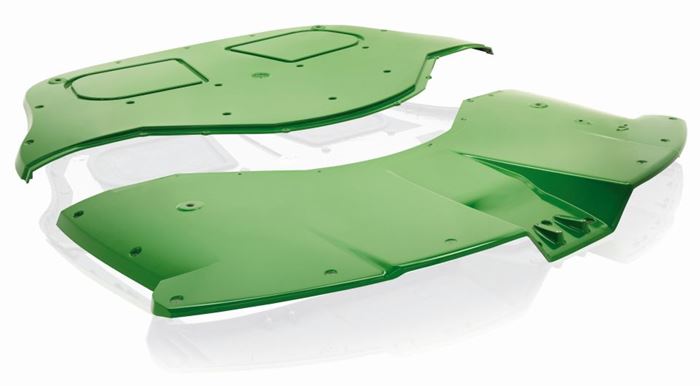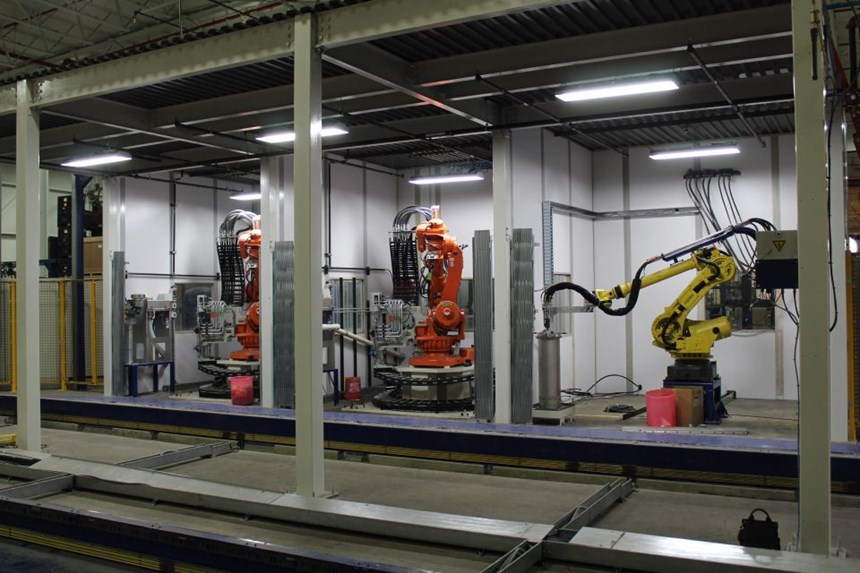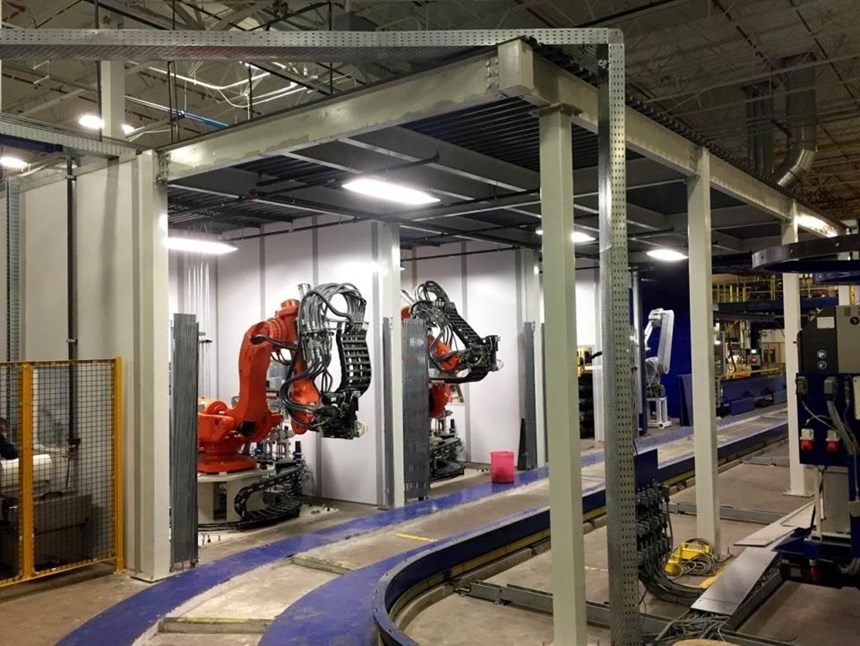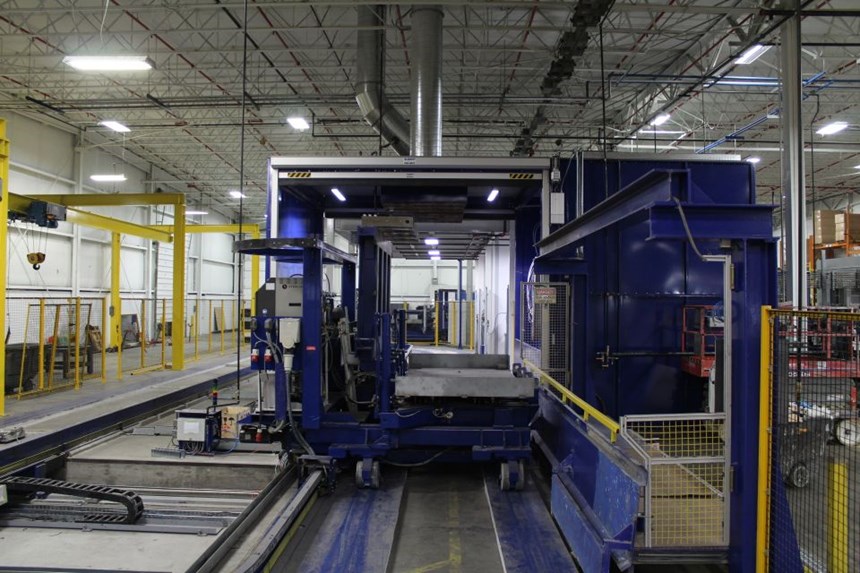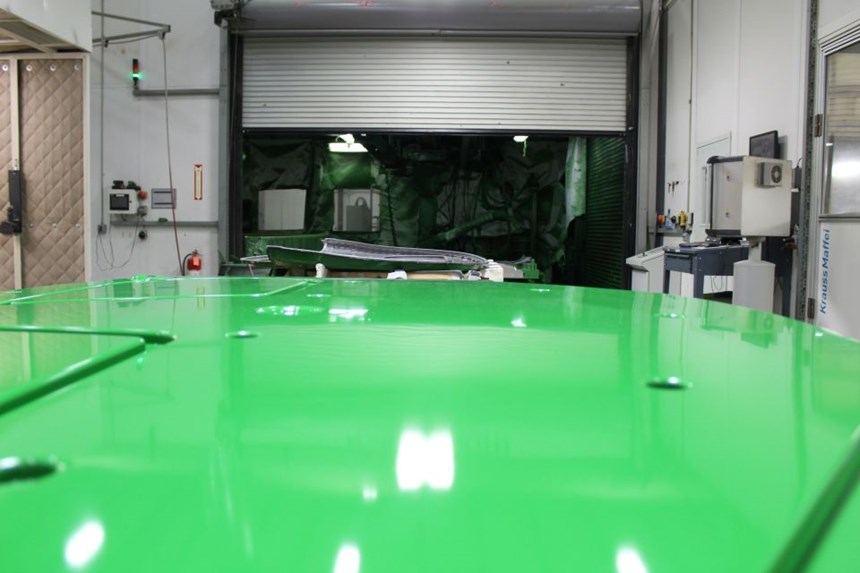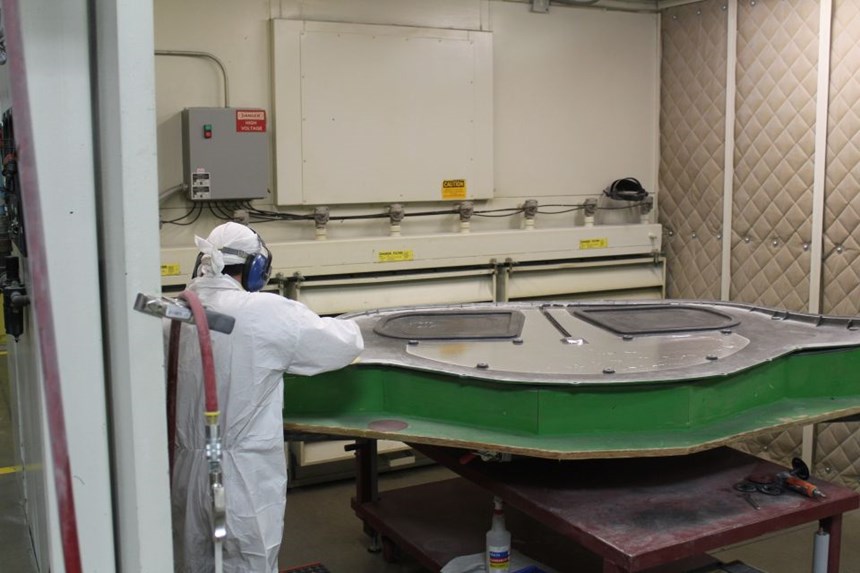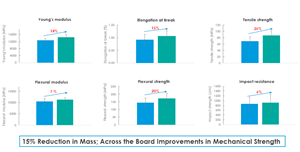Large, Class A parts every 60-150 seconds
Romeo RIM advances long fiber injection process efficiency for lighter, lower-cost composite parts.
Established in 1982, Romeo RIM Inc. (Romeo, MI, US) commands >70% of the North American market for energy-absorbing bumpers on vehicles such as transit buses, airport shuttles and light trucks, made using the reaction injection molding (RIM) process. RIM can produce both unreinforced polyurethane (PU) structures such as vehicle bumpers, but also long and short fiber-reinforced parts such as body panels via reinforced RIM (RRIM, see Table 1). The company is also a leader in the related long fiber injection (LFI, see ”Long-Fiber Injection Advances Polyurethane Composites”) composite manufacturing process, which it initially used for heavy truck sleeper cab applications in the late 1990s.
Developed by KraussMaffei Technologies GmbH (Munich, Germany and Florence, KY, US), Romeo RIM’s LFI presses use a robotic mix head equipped with a chopper to apply long (typically 1-inch/25.7-mm) glass fiber and mixed PU resin into a tool coated with in-mold paint (IMP). The two-part matched metal mold is closed and the resin and fiber mixture is compression molded. Resulting parts, with Class A finish straight from the mold, are reportedly up to 80% lighter than steel, 60% lighter than aluminum, 40% lighter than sheet molding compound (SMC) and 50% lighter than hand layup/sprayup fiber-reinforced plastic (FRP).
Cycle time is typically 5-10 minutes — the higher end of this range for larger parts that can range to 3.5m by 3.5m. Romeo RIM, however, is now able to demold large Class A parts with molded-in B-side features every 60-150 seconds thanks to a new system which uses a multi-press arrangement that takes advantage of robotics and a carousel-type arrangement that makes manual processing steps more efficient.
Mobile molds, digital efficiency
The chemical reaction of the thermoset polyurethane resin used in LFI determines the cure time in the mold, explains Romeo RIM vice president of business development Matt Getty. Thus, Romeo RIM’s 5- to 10-minute cycle time using LFI was fixed, prompting it to seek other means to improve process efficiency.
“Historically, this was downtime for the press operator, as we waited for the cure to complete before demolding and refilling for another part,” Getty recalls, “but we have developed a new processing approach using new equipment to better utilize this time. We still paint and fill the mold,” he explains, “but then we send it around a rotary turntable like a carousel.” A multiple-robot material dispensing unit (Step 1) services seven molding presses on that carousel.
Getty notes that because LFI uses relatively low pressure (5 bar/75 psi) compared to typical thermoplastic injection molding processes (1,500-2,500 bar/20,000-30,000 psi) and compression molding of sheet molding compound (25-172 bar/500-2,500 psi), Romeo RIM’s LFI presses are typically lower tonnage, 150-500 tons. “These presses move around the circuit with a mold inside,” he explains, “and are electronically controlled to open for paint and composite materials to be applied [Step 2], then closed for cure as they traverse the circuit, ending up at a demold station [Step 3] where they open for the finished part to be removed.” The mold then begins the circuit again.
“The 5- to 10-minute cycle time is now divided by seven molds per rotary carrier,” says Getty. As a result, “the operator at the demold station is pulling a part every 60 to 150 seconds, allowing us to achieve higher production volume with the same labor for a single part. Typically, our customers are looking at 1,000 to 100,000 parts per year, which we can produce without needing to invest in more dispensing equipment or labor.”
This multi-mold, carousel approach also offers interesting production capabilities. “We can produce seven different parts in the rotary carrier,” notes Getty, “and each can be coated with the customer’s own unique color and surface texture.” This is possible because Romeo RIM has digitized its IMP method. “We can paint matte gray for a spa,” Getty says by way of example, “and then, for the next mold in the carousel, apply a high-gloss yellow paint specified to match per the customer.” [Step 4]. “We can also change textures for surface aesthetics,” he adds, pointing out that wood grain or a geometric pattern can be machined into the aluminum or steel molds. “One after the other, we produce parts with all different colors and surface finishes, all robotically applied, and customers benefit from process efficiency and economies of scale, with less overhead attached to each part.”
Part cost and complexity
The lower pressure of LFI not only drives down press costs, but has the additional benefit of reducing tooling expense. “Our mold costs are lower than SMC,” says Getty, “so overall part cost is less as well.” Lower pressure does not, however, place a limit on part complexity. “In terms of molding details, we’re comparable to SMC and resin transfer molding,” he replies. We can mold grids and bosses into the B-side of a Class A part. We can also put inserts into the mold and overmold these, but more often, we mold-in an attachment to receive a threaded fastener.”
Typical fiber content in LFI parts is 30-40% by weight. At this level, part complexity can be limited by fiber length. “We can use longer or shorter fibers, but through development work, we’ve found that one inch gives a good balance between mechanical properties and geometrical complexity,” Getty explains. “Too long of a fiber won’t be as easy to wet out in complex geometry parts, and too short of a fiber length reduces mechanical properties.”
“Because we make large parts, we’re typically able to consolidate many different parts into a single integrated component,” says Getty. “These are the types of applications we look for, in fact, and they typically require incorporating B-side features.” Getty concedes that for very deep and narrow B-side features, such as ribs or brackets, the fiber content would be slightly less than in the rest of the molded part, an inherent result of the low-pressure LFI process as fibers are not easily forced into thin and far extremities without higher pressure. “There is a gradient in fiber content from the base to the top of the rib,” he explains. Thus, tips and edges with less reinforcement will not be as strong. “We understand this, so we work closely with our customers’ engineers to ensure we deliver parts that perform to their needs and expectations.”
Applications, advantages and future developments
Getty says LFI offers significant advantages vs. other composite processes for a wide range of applications. “By leveraging IMP, we can produce a large roof for agricultural or construction equipment with Class A finish plus B-side features in less than 10 minutes,” he asserts. “For body cladding, our density is lower vs. SMC or hand layup FRP, while LFI mechanical properties are still high in stiffness, similar to other composites.” Getty adds that polyurethane also is a unique thermoset in that it has very high impact resistance — enough to withstand rock impacts. Indeed, Romeo RIM received an Award for Composites Excellence (ACE) in material and process innovation by the American Composites Manufacturers Assn. (ACMA) in 2013 for a Class A harvest vehicle roof with mechanical properties comparable to SMC but at 45% of the weight and a cost 20% Less than traditional topcoat systems.
For now, glass fiber is the reinforcement of choice, but this could change. “I think there is a lot of opportunity with current materials, but we’re also looking at alternative resins and fibers, including carbon,” says Getty. He believes it might also be possible to use nanomaterials, which, if developed appropriately, could be incorporated into one or both monomers, similar to how they are added in RRIM.
With regard to Industry 4.0, Romeo RIM’s equipment collects all temperatures and pressures during IMP and molding, which can be logged and reported. But even as the company invests in new technologies, it maintains its core strengths. “We have a well-developed knowledge of this process through many years and applications,” says Getty. “This is why we work with our customers, performing design and engineering side-by-side, so they can exploit our experience to obtain the customized parts they want, but at less weight and lower cost.”
For more background on Romeo RIM, see “Romeo RIM install’s world’s largest long fiber injection machine” and “LFI process: Molding strong and attractive spa enclosures”.
Related Content
Graphene-enhanced SMC boosts molded component properties
CAMX 2023: Commercially sold GrapheneBlack SMC from NanoXplore increases part strength, stiffness and provides other benefits for transportation, renewable energy, energy storage and industrial markets.
Read MoreMaterials & Processes: Fabrication methods
There are numerous methods for fabricating composite components. Selection of a method for a particular part, therefore, will depend on the materials, the part design and end-use or application. Here's a guide to selection.
Read MoreComposite resins price change report
CW’s running summary of resin price change announcements from major material suppliers that serve the composites manufacturing industry.
Read MoreCAMX 2022 exhibit preview: Cimbar Performance Minerals
Cimbar’s halogen-free ATH solution for thermoset applications reduces resin costs in formulation, provides better wetout and faster line speeds and improves mold flow.
Read MoreRead Next
CW’s 2024 Top Shops survey offers new approach to benchmarking
Respondents that complete the survey by April 30, 2024, have the chance to be recognized as an honoree.
Read MoreComposites end markets: Energy (2024)
Composites are used widely in oil/gas, wind and other renewable energy applications. Despite market challenges, growth potential and innovation for composites continue.
Read MoreFrom the CW Archives: The tale of the thermoplastic cryotank
In 2006, guest columnist Bob Hartunian related the story of his efforts two decades prior, while at McDonnell Douglas, to develop a thermoplastic composite crytank for hydrogen storage. He learned a lot of lessons.
Read More

